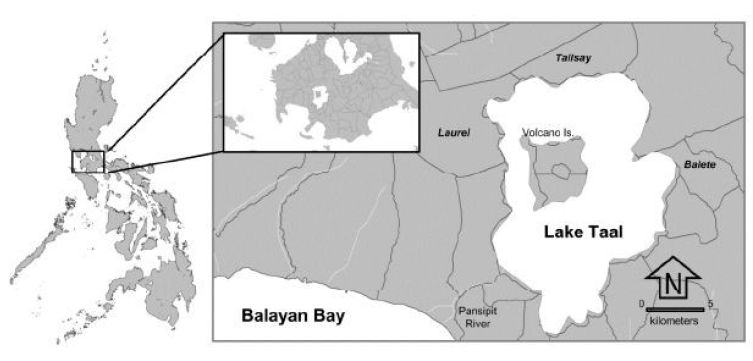VOLUME 6 NUMBER 1 (January to June 2013)

Philipp. Sci. Lett. 2013 6 (1) 021-028
available online: February 21, 2013
*Corresponding author
Email Address: jonathancarlo@ymail.com
Received: May 14, 2012
Revised: January 4, 2013
Accepted: January 6, 2013
SHORT COMMUNICATION
Initial assessment of parasite load inClarias batrachus, Glossogobiusgiuris and Oreochromis niloticus inLake Taal (Philippines)
by Gil Cauyan1, 2, Jonathan Carlo Briones3*, Eugene De Leon1, JulioArsenio Gonong1, Eduardo Omar Pasumbal1, Ma. Czarina IsabelPelayo1, Manuel Anthony Piñera1, Rey Donne Papa1,2
1Department of Biological Sciences, College of Science, University of Santo Tomas,
Manila, Philippines
2Research Center for the Natural and Applied Sciences, University of Santo Tomas,
Manila, Philippines
3Graduate School, University of Santo Tomas, Manila, Philippines
Manila, Philippines
2Research Center for the Natural and Applied Sciences, University of Santo Tomas,
Manila, Philippines
3Graduate School, University of Santo Tomas, Manila, Philippines
Fish parasites are ecologically important because theyshape community and ecosystem structure byinfluencing trophic interactions, host fitness, andfood webs. We surveyed fish parasitofauna fromLake Taal and provided initial quantitative andqualitative measures of parasite burden. This was then correlatedwith fish size, as a preliminary attempt to relate parasitism withfish overall fitness. A total of 60 specimens of Oreochromisniloticus, Glossogobius giuris and Clarias batrachus werecollected from the lake in June, October and November 2010.From these, five taxa of digenetic trematodes (Opegaster sp.,Erilepturus sp., Euclinostomum sp., Orientocreadium sp., andClinostomum sp.) and one parasitic cyclopoid (Lernaea sp.)were collected and identified. Results revealed that the mostprevalent parasites, in both occurrence and number, wereOpegaster sp. in G. giuris and C. batrachus, and Lernaea sp. inO. niloticus. C. batrachus was the most burdened as it harboredparasites in most of its internal organs. Linear correlations revealnegative trends between parasite burden and fish size for all fishspecies analyzed, suggesting that smaller fish tend to harbormore parasites than larger fish. However, this relationship wasnot found to be statistically significant (p>0.05). Nevertheless,these results reveal the challenges that many researchers willface in their effort to understand the implications of parasitism toboth caged and feral fish, in relation to natural andanthropogenic factors. Moreover, it highlights the need for moreecological studies on parasitism in the Philippines, if we are toimprove fish conditions in both open waters and caged areas notonly in Lake Taal, but also in all Philippine lakes, especiallythose that are being utilized for aquaculture.
© 2025 SciEnggJ
Philippine-American Academy of Science and Engineering